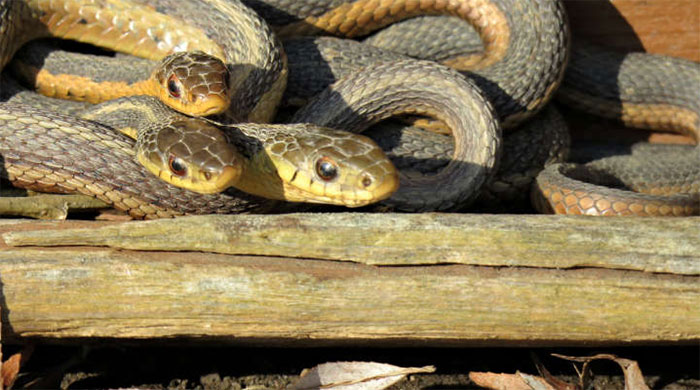Surprise the friendship of one of the world's most lonely and cold creatures
However, a new study shows that their relationship to fellow humans may, in fact, be more complex than we thought.
At Wilfrid Laurier University, Canada, 40 young striped snake ( Thamnophis sirtalis) young, native to Southeast and most of North America, were placed in a chamber with 4 separate shelters in groups of 10. For eight days, psychologist comparing Noam Miller and his student Noam Skinner watched these snakes (marked with colored dots) crawl in and around the shelter.

These snakes seem to actively seek social interaction.
Twice a day, the locations of the snakes are recorded, where they are kept from eliminating all odors, and then they are put back into other positions. Aside from the fact that these snakes seem to actively seek social interaction, clustered in groups of three to eight, they have also been found to regularly gather together with one. These groups - in any way - are surprisingly similar to mammalian groups, including humans, Skinner said.
In fact, other animals have been shown to have 'close friends'. Flamingos maintain friendships for several years (and actively avoid others), while demon bats foster friendships with French kisses with their bloody mouths. But snakes are seldom included in such studies, because the predetermined notion that they are also really cold to their fellow humans.
As Skinner and Miller explain in their paper published in the Journal of Social and Behavioral Biology: 'that view is further compounded by the fact that in some reptiles, the social interactions concealed, due to their secret characteristics, and these social behaviors are often performed through invisible chemical signals. '
To understand more about this deserted path of study, the two teachers and students also tested the personality of snakes when evaluating their audacity. Both in individual and group scenarios, they measured the time it took the snake to exit the shelter.
The daring ones explore the area where they are kept, while the more shy ones remain inside the shelter. These single differences ultimately affected the way they interacted with each other, although the more aggressive snakes did not succumb to the so-called 'herd mentality' when clustered with 'friends' , They spend 94% of their time in their comfort zone.
However, this may be their advantage, because in nature, such groups can protect them from prey and help retain heat and moisture. Although this study was only conducted under laboratory conditions, the authors maintain that these social behaviors also occur in nature as well as among other reptiles.
Moreover, the discovery of snakes also prefers a few other animals that may help with conservation efforts, since moving them along a 'group of friends' can prevent them from escaping a safe habitat.
Although scientists still do not know what makes the friendship between these long-striped snakes, it seems that snakes crawling together will be together.
- Does the friendship between men and women exist?
- What is the most lonely human being?
- Discover the most lonely creature on the planet
- France blocks 'gate connecting the worlds'
- 8 countries 'most lonely' in the world
- The strange banana species in the middle of Xuan Son forest is still alone, finishing and killing itself
- Gender friendship can help men reduce stress
- Can there be pure heterosexual friendship?
- The most lonely job in the world
- America celebrates the 50th anniversary of the first flight around the Earth
- America is so cold that sharks have to freeze to death
- Dogs make friends with orangutans
 Animal 'suffering' after hibernation
Animal 'suffering' after hibernation Why do goats climb well?
Why do goats climb well? Scientists were surprised to see chimpanzees eating turtles
Scientists were surprised to see chimpanzees eating turtles Giant catfish died deadly due to drought in Thailand
Giant catfish died deadly due to drought in Thailand